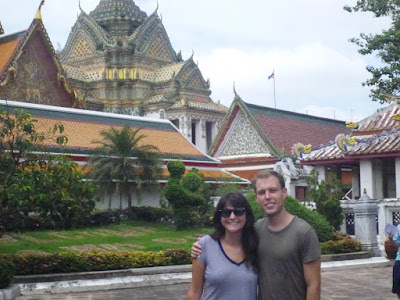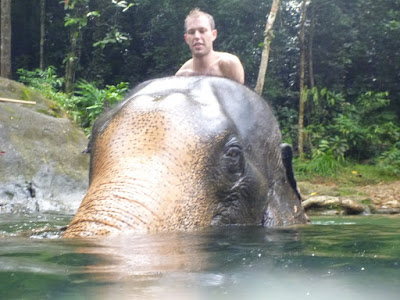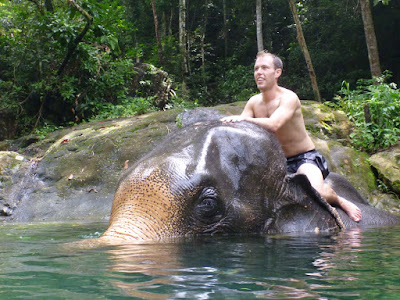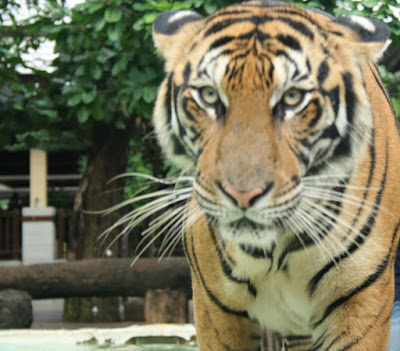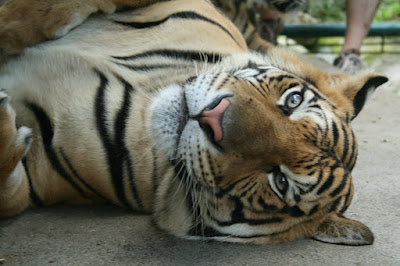Jess, I can’t stop listening to it!
Okay, okay, Mom, I’m updating my blog already. I have to say this will be one of my favorite weeks to share with everyone, since it was one of my favorite weeks on the trip so far.
I flew into Bangkok a couple days ahead of my planned reunion with Jessica Hinojosa (Jess, aka Shakes), one of my besties from Camp Kesem and Summer-On-Campus 2010.
Jess, for those of you unfortunate enough not to know her
Jess and I had been planning on meeting in Thailand since way before my trip started. She would be on her way to India to begin a few weeks there leading a trip full of geo-nerds around the Himalayas, and I would be just about in the right part of the world for a reunion. Perfect.
Bangkok is a really amazing and surprising city. Thai culture, being predominantly Buddhist rather than Muslim, is a lot more liberal than what I saw in Malaysia. Buddhist philosophy, after all, is all about personal enlightenment, and only through that does it touch on societal norms. In contrast, Muslim philosophy (and Christian for that matter) often preaches how societies should act and how certain groups should be treated. The “live and let live” philosophy has created in Thailand a people who are extremely tolerant of differences. You only need to see a massive troupe of cross-dressers marching down a street, laughing and joking with the street vendors in a relatively provincial town, to understand that this country definitely has a different concept of what’s okay. The downside, of course, is that it’s also created a culture rife with excesses – sexual excesses in particular. Being a white male in Bangkok can be alarming sometimes, since you’re basically constantly rebuffing offers for ‘ping pong’ shows (live sex shows) and massages (not the innocent kind).I couldn’t walk down a street without being offered sex at every street corner, it seemed. Also unfortunately, the reason why a person like me gets so many lurid offers is because I’m part of a demographic (while male aged 20+) that has made the sex trade in Thailand so successful. It was common (after a week, unremarkable) to see an older white man walking down the street hand-in-hand with a young attractive Thai woman. The transparency of the situation made it so much more repulsive.
But despite all that, Bangkok has so much to appreciate. First and foremost, for me, was the food. I already knew I liked Thai food from going to Thai restaurants often in the States, but oh lord. The real thing is so much better. Being surrounded by amazing, cheap, easy-to-get-to Thai food put me in heaven the whole time I was in Thailand. And did I mention the Thai Iced Coffees? UGH, get me back there.
The day Jess got into Bangkok we hit the ground running and went on a tour of the temple district, near the Royal Palace.
A Buddhist temple along the river
Wat Po, home of the amazing (-ly large) reclining Buddha
The reclining Buddha's feet. Inlaid mother-of-pearl.
Sunrise Temple. Steep Stairs!
Dress properly! Men: no pants. Women: like vampires.
Reunited at last!
Being the travel-robot that I am, I didn’t appreciate until later how much of a trooper Jess was that day. Getting in at 6am after two days of travel straight into a long day of sightseeing – what a champ! We ended the day with a visit to a very trendy rooftop bar, where we had massive cocktails and cheers-ed to the upcoming week.
We got out of Bangkok early the next day, because we knew our time was short. We took a bus south to an island called Ko Chang
Ko Chang was a great, relaxing way to start our week. We spent our first afternoon there exploring the beach and nearby beachside bars.
The next morning we got a late start, which thwarted our plans to go snorkeling in the archipelago to the south of Ko Chang, but lucky for us it opened up the opportunity to go and visit an elephant sanctuary in the middle of the island.
We signed up for a two-hour trek with an elephant, and his handler. The elephant we got, “Rambo”, was by far the biggest at the camp. I swear to god he was at 11 feet tall to his head, and later research revealed he would have weighed around 14,000 pounds. Despite his size, he was obviously a very gentle animal at heart. Our ride included a 30-minute trek out to a deep pool in a nearby jungle stream, an hour-long swim session with Rambo, and 30 minutes back. It was… well, I’ll let the pictures speak for themselves.
He loooved to be scrubbed and washed. He basically just leaned up against this rock and dozed while I scrubbed him
This was definitely one of my highlights to my entire trip. Swimming with Rambo, just me, Jess, and his handler all alone in the middle of the jungle, in the fresh cold water… really amazing. Did you know elephants have the biggest cerebral cortex (the part of the brain responsible for cognitive processing) of any animal on earth? Rambo definitely knew what was going on - you could see his intelligence behind his eyes.
Although “Elephant Tourism” is big in Thailand, it unfortunately it has a dark side along with the amazing things it can provide. We didn’t know it going in, but we were lucky that we chose one of the better sanctuaries. The elephants at the place we went to, Ban Kwan Chang elephant refuge, were all formerly working elephants either in the logging industry or in the vile “elephant show” industry. In both cases, the elephants go through a “breaking” process called Phajaan, in which they are basically beaten into submission. When the elephants are too old to perform, they are often abandoned or sold to shady operations. At Ban Kwan Chang their lives are a lot better, even though as a result of the Phajaan the mahmout (handler) for Rambo still had to use a hook to correct his behavior sometimes. He was trained to respond to it, so it unfortunately becomes a necessary evil for the rest of his life (Phajaan trained elephants are very hard to retrain). The trick I guess is just to minimize the use of harsh corrections and to otherwise provide them with a good lifestyle, which judging by how much Rambo loved his swim and getting fed on the way back, I think Ban Kwan Chang did pretty well.
We ended a nearly perfect day perfectly by getting a massage on the beach and hitting a nearby bar for drinks and dinner.
Or next day was our last in Koh Chang, so we decided to hike our way to one of the major waterfalls on the island. Unfortunately, those pictures are still trapped in Jess’ camera, so you’ll just have to imagine it. Here are some key words to get your imagination going: perfect jungle waterfall. Got it? Thought so.
We wrapped up an amazing trip to Koh Chang with a great seafood meal on the southern tip of the island, before making our way back to the mainland and the nearby airport, to hop on a short flight to Chiang Mai, via BKK.
Chiang Mai is the adventure capital of Thailand. Located in the jungle-covered northern interior, it’s the perfect place to have some outdoor adventures. It’s also a university town, and the educational atmosphere extends to the populace in the form of various schools of all types – everything from cooking to kickboxing.
Our first morning in Chiang Mai we spent Temple-hopping.
The real highlight of the day, however, came in the afternoon when we went to visit Tiger Kingdom.
Yes, this is a place where they let you play with tigers. During the day, tigers, like most cats, are pretty sedate. Since these cats have been born and raised in captivity, they not only are used to, but expect lots of human contact every day. They are basically great big Labradors, including the part where they roll over and expect a belly rub. Besides being totally terrifying, it was really amazing to pet and be so close to such an incredible animal. Of course, Tiger Kingdom is also a good place to learn about the Asian Tiger, which is critically endangered.
The next day, we decided to get our learning on and took a full day cooking course. To say that I was excited about this would be a dramatic understatement. I’ve already described my love for Thai food, and the prospect of being able to cook it on my own back in the States, I’m pretty sure, would result in measurable increases in my everyday happiness. These photos, too, are unfortunately trapped on a camera in India somewhere, but I can assure you it was magical. We went to the market in the morning to learn about buying fresh ingredients, and then we cooked (and ate!) 7 courses throughout the morning and afternoon. We had a huge menu to choose from, and I chose to learn to make a starter (spring rolls), a soup dish (chicken coconut soup), a noodle dish (pad thai), a non-curry main (cashew chicken), a curry paste (red), a curry main (with chicken), and a dessert (sweet sticky rice with mango). On top of all that, we got a great big cookbook with all the recipes, including the ones we didn’t learn. This was such an awesome way to spend a day in Chiang Mai, and we left stuffed to the gills with food and knowledge.
The next day we woke up early and went up into the mountains near Chiang Mai to the Royal Palace and Wat Prahthat Doi Suteph, the mountain temple with the most holy chedi (tower-like centerpiece) in all of Thailand. Legend says that a white elephant bearing a unique image of the Buddha was set loose from a temple in Chiang Mai long ago, and the elephant wandered until it found the spot where Wat Prahthat Doi Suteph now stands, and died, leaving the Buddha there to stay. Both the palace and the temple were beautiful, but again the pictures are unavailable at the moment. Google it if you really need to know, but if you can imagine a beautiful mountain temple, complete with foggy clouds rolling over the terraces and the thick smell of incense everywhere, then you’re 90% of the way there.
We caught an overnight bus back to Bangkok that night, sad to leave Chiang Mai. Jess flew out the following day to start her adventures in India. I stuck around another day to visit my favorite street restaurant one more time (okay, two more times), where I finally got up the nerve to ask to watch them make the Pad Thai, since I had a grasp for the different flavors after my cooking class. They were happy to oblige, and I have some useful notes added to my cookbook now. The next day, I took a bus to Cambodia. That update’s coming soon!
LOVE lots,
Clay (and Jess)











































